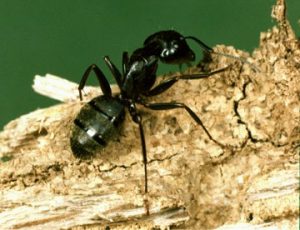
Camponotus pennsylvanicus (carpenter ant)
REVIEW
A Field Guide to the Ants of New England, Aaron M. Ellison, Nicholas J. Gotelli, Elizabeth J. Farnsworth, and Gary D. Alpert, Yale University Press, 2012.
By David Lubertazzi, Ph.D., Museum of Comparative Zoology, Harvard University
Most people can readily identify a foraging ant as an ant. Some even go as far as distinguishing between different kinds of ants, red versus black or small versus large. Getting beyond this rudimentary level of identification with ants has largely been impossible for most people in Rhode Island – at least up until last November. The newly published Ants of New England provides the curious naturalist their first opportunity to learn about the ants that occur in the state. Prior to the publication of this guide even ant biologists could find little more than an incomplete list of species names for the region. Identification keys, for genera that had them, were scattered in taxonomic publications, fraught with problems and left much to be desired. This book moves us from being unsure about what ants even occur in New England to having what is arguably the most usable regional ant guide ever published.
Beyond platitudes, interested naturalists might like to know what a $30 investment in The Ants of New England might return. The book covers many important ant basics in a way that is easy to read and comprehend. Coverage of topics such as how to collect ants, basic ant biology and New England ant diversity is also quite well done. In sum, all necessary context is provided for anyone that wants to prepare to explore and investigate the local ant fauna.
The bulk of the guide is dedicated to providing identification and biological details about the ant species that occur in New England. This is where this book stands head and shoulders above any other previously published ant book. It is rich with ant and habitat photographs, illustrations and occurrence maps. There are separate dichotomous keys for the six New England ant subfamilies, the 31 genera and all the species within each genus. Such keys are standard fare for many species level guides—and the keys alone are a tremendous advance regarding our understanding of our local ant species—but there is much more. There are innovative matrix keys for tricky-to-tease-apart species groups. Each species treatment includes a list of distinguishing morphological features, details about differences with similar species and an accounting of the habitats where each ant occurs. Lavish illustrations and photographs enhance all the written details. An ant guide that so richly goes beyond the standard dichotomous key format is extremely useful to amateurs and specialists alike. Armed with this guide, a hand lens, and time to spend looking for and at ants, one could become quite adept at identifying Rhode Island’s ants to genus and, for the majority of forms, to species. In identifying ants you collect you will also begin to learn about the fascinating ways that ants manage their intricate social lives.
There are a fair number of specialized morphological terms used for identification, as is the case with many identification guides. Fortunately all the terms are nicely illustrated in the back of the book. With all of the images and drawings included with the keys one can manage to identify many forms to genus without having to learn many specialized terms. Yet identifying some of the more difficult to separate species in this guide can be challenging, requires the use of a stereo-microscope, and will surely require reference to the illustrated guide to the morphological terms. Regardless, that a single book may allow the level of resolution in ant identification that this book does, represents quite an advance.
Rhode Island is the most poorly sampled for ants of all the New England states. Specialists estimate there are about 100 species that should occur here. We are only slightly more than halfway to documenting this number of species with actual collection records. With a predicted total species richness of 153 ant species for all of New England it is now possible, through more collecting, really to begin to understand where Rhode Island stands in relation to the larger regional fauna.
If you are a naturalist who spends time outdoors and are curious about ants, purchasing this guide now means you can study up while the ants are dormant. You will have all winter to prepare for your first ant collecting forays in late spring!